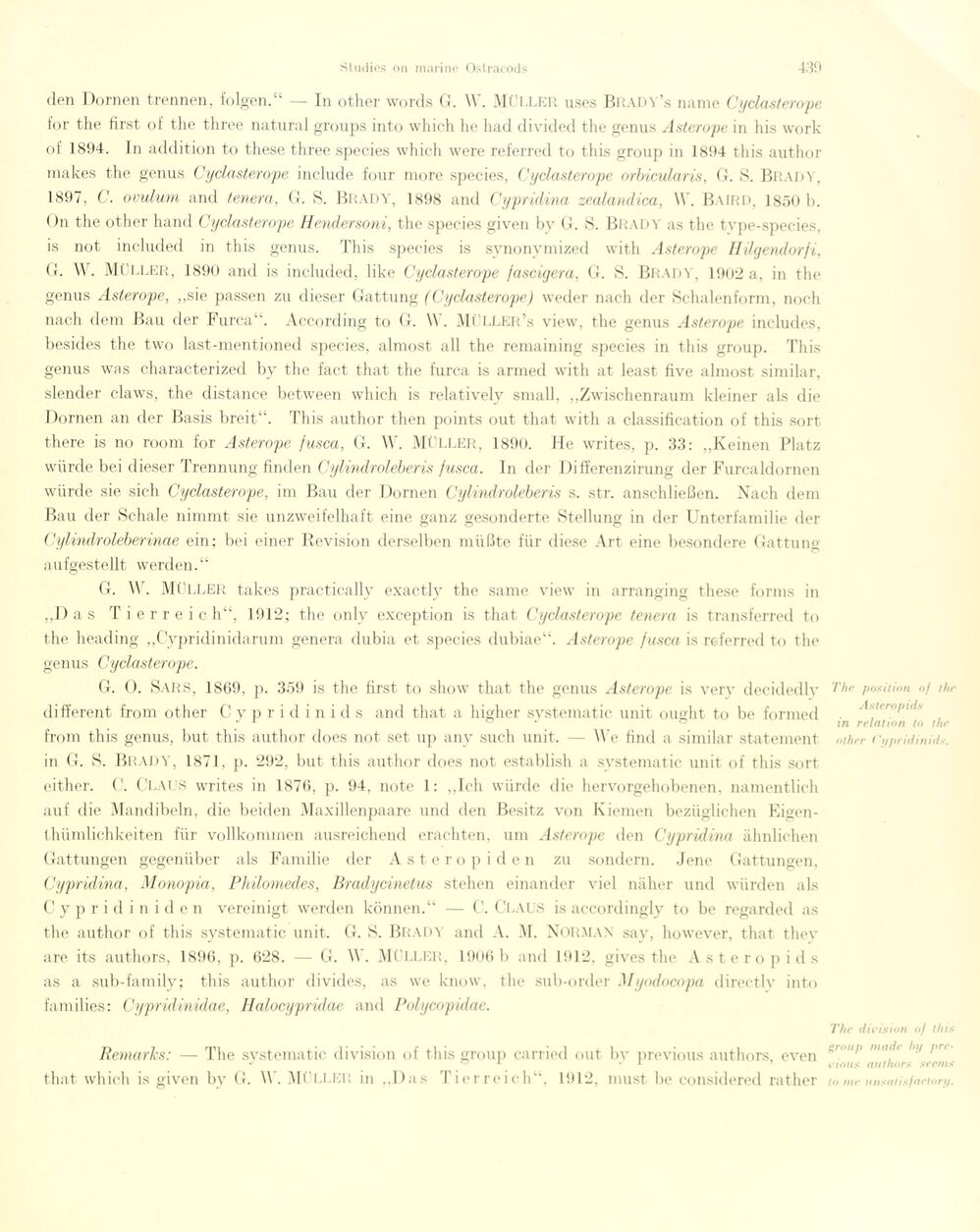
Full resolution (JPEG) - On this page / på denna sida - Sidor ...

<< prev. page << föreg. sida << >> nästa sida >> next page >>
Below is the raw OCR text
from the above scanned image.
Do you see an error? Proofread the page now!
Här nedan syns maskintolkade texten från faksimilbilden ovan.
Ser du något fel? Korrekturläs sidan nu!
This page has never been proofread. / Denna sida har aldrig korrekturlästs.
den Dornen trennen, folgen.“ — In other words G. \Y. MÜLLER uses Brady’s naine Cyclasterope
for the first of the three natural groups into which he had divided the genus Asterope in his work
of 1894. In addition to these three species which were referred to this group in 1894 this author
makes the genus Cyclasterope include four more species, Cyclasterope orbicularis, G. S. Bram .
1897, C. oculum and tenera, G. S. Brady, 1898 and Cypridina zealandica, \Y. Baird, 1850 b.
On the other hånd Cyclasterope Hendersoni, the species given by G. S. Bram as the type-species,
is not included in this genus. This species is synonymized with Asterope Hilgendorfi,
G. W. Müller, 1890 and is included, like Cyclasterope fascigera, G. S. Bram , 1902 a, in the
genus Asterope, „sie passen zu dieser Gattung (Cyclasterope) weder nach der Schalenform, noch
nach dem Bau der Furca“. According to G. \Y. MëLLER’s view, the genus Asterope includes,
besides the two last-mentioned species, almost all the remaining species in this group. This
genus was characterized by the faet that the furca is armed with at least five almost similar,
siender claws, the distance between which is relatively small, „Zwischenraum kleiner als die
Dornen an der Basis breit“. This author then points out that with a classification of this sort
there is no room for Asterope fusca, G. W. MULLER, 1890. He writes, p. 33: „Keinen Platz
würde bei dieser Trennung finden Cylindroleberis fusca. In der Differenzirung der Furcaldornen
würde sie sich Cyclasterope, im Bau der Dornen Cylindroleberis s. str. anschließen. Nach dem
Bau der Schale nimmt sie unzweifelhaft eine ganz gesonderte Stellung in der Unterfamilie der
Cylindroleberinae ein; bei einer Revision derselben müßte für diese Art eine besondere Gattung
aufgestellt werden.“
G. W. MÜLLER takes practically exactly the same view in arranging these forms in
„Das Tierreich“, 1912; the only exception is that Cyclasterope tenera is transferred to
the heading „Cypridinidarum genera dubia et species dubiae“. Asterope fusca is referred to the
genus Cyclasterope.
G. O. Sars, 1869, p. 359 is the first to show that the genus Asterope is very decidedly
different from other Cypridinids and that a higher systematic unit ought to be formed
from this genus, but this author does not set up any such unit. — \Ye find a similar statement
in G. S. Brady, 1871, p. 292, but this author does not establish a systematic unit of this sort
either. G. CLAUS writes in 1876, p. 94, note 1: „Ich würde die hervorgehobenen, namentlich
auf die Mandibeln, die beiden Maxillenpaare und den Besitz von Kiemen bezüglichen
Eigen-thiimlichkeiten für vollkommen ausreichend erachten, um Asterope den Cypridina ähnlichen
Gattungen gegenüber als Familie der Asteropiden zu sondern. Jene Gattungen,
Cypridina, Monopia, Philomedes, Bradycinetus stehen einander viel näher und würden als
Cypridiniden vereinigt werden können.“ — C. CLAUS is accordingly to be regarded as
the author of this systematic unit. G. S. Brady and A. M. NORMAN say, however, that they
are its authors, 1896, p. 628. — G. \Y. MULLER, 1906 b and 1912. gives the Asteropids
as a sub-family; this author divides, as we know, the sub-order Myodocopa directly into
families: Cypridinidae, Halocypridae and Polycopidae.
Remarks: — The systematic division of this group carried out by previous authors, even
that which is given by G. \Y. MULLER in „Das Tierreich“, 1912, must be considered rather
The position oj the
Asteropids
in relation to the
other (1i/pridin ids.
The division o/ thts
group made by
pre-v ions authors seems
to me unsatisfaetonj.
<< prev. page << föreg. sida << >> nästa sida >> next page >>